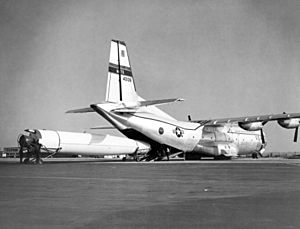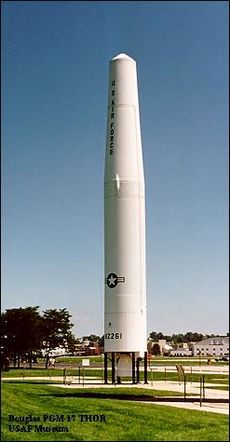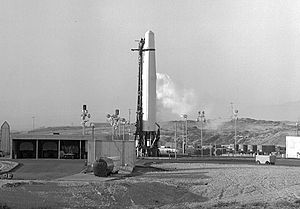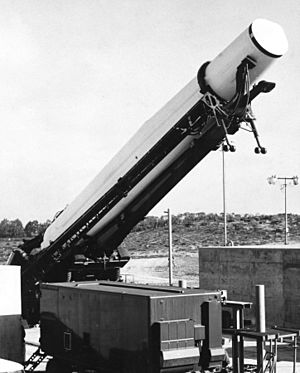Project Emily facts for kids
Quick facts for kids Project Emily |
|
|---|---|
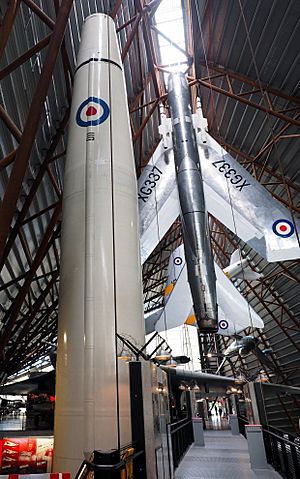
A Thor missile (left of an English Electric Lightning plane) at the RAF Museum Cosford.
|
|
| Commercial? | No |
| Type of project | Missile deployments |
| Country | United Kingdom |
| Prime Minister(s) | Harold Macmillan |
| Key people | Dwight D. Eisenhower |
| Established | 1959 |
| Disestablished | 1963 |
| Website | Lua error in Module:Wikidata at line 70: attempt to index field 'wikibase' (a nil value). |
Project Emily was a special plan to place American-made Thor missiles in the United Kingdom. These missiles were called IRBMs because they could travel a medium distance. This project happened between 1959 and 1963.
The Royal Air Force (RAF) used 60 Thor missiles. These missiles were spread out across 20 different RAF air stations. They were an important part of Britain's plan to protect itself with nuclear weapons.
In 1957, the US President Dwight D. Eisenhower and British Prime Minister Harold Macmillan met. They were worried about the Soviet Union building up its missiles. They talked about putting IRBMs in the UK for a short time. This would be until longer-range missiles, called ICBMs, were ready. The launch of the Soviet satellite Sputnik in October 1957 made this plan happen much faster.
The first Thor missile arrived in the UK in August 1958. It came on a large transport plane. The RAF officially received it in September. RAF crews went to the United States for training. They even launched 21 training missiles from Vandenberg Air Force Base.
During the Cuban Missile Crisis in October 1962, 59 of the Thor missiles were made ready for launch. They had powerful nuclear warheads. The Thor missile force was ended in 1963. The missiles were sent back to the United States. Most of them were later used for military space launches.
In October 2012, the old launch sites at RAF Harrington and RAF North Luffenham were given special protected status.
Contents
Why Project Emily Started
Britain had its own nuclear weapons project during World War II. It was called Tube Alloys. In 1943, Britain and the United States agreed to work together. They combined their projects to create the Manhattan Project.
After the war, the US stopped sharing nuclear technology. This was due to a new law called the McMahon Act. Britain then started its own nuclear weapon development again. This was called High Explosive Research. Britain successfully tested its first atomic bomb in 1952. The first bombs were given to the RAF in 1953.
Britain's nuclear weapons were first carried by V-bomber planes. But experts thought these planes might become old-fashioned by the late 1960s. So, in 1953, the RAF asked for a plan for a new type of weapon. This was a ballistic missile that could fly about 2,300 miles (3,700 km). This plan became known as OR.1139.
Work on this missile, called Blue Streak, began in 1954. The US was also developing a very long-range missile, the Atlas. The US agreed to help Britain with Blue Streak.
At the same time, the US was also developing three different types of IRBMs.
- The US Army developed the Jupiter missile. Its first successful flight was in May 1957.
- The US Navy worked on a smaller missile called Polaris. This one could be launched from submarines.
- The US Air Force (USAF) developed the Thor missile. The Douglas Aircraft Company built it. The first successful test flight of Thor was in September 1957.
How the Deal Was Made
The Thor missile could fly about 1,700 miles (2,400 km). This wasn't far enough to reach the Soviet Union from the United States. So, the US needed to place these missiles in other countries. Britain, Germany, and Turkey were considered.
Talks about placing Thor missiles in Britain began in 1956. The US could not give nuclear weapons to Britain because of the McMahon Act. However, the missiles could use British nuclear warheads. But these would be heavier, making the missile's range shorter.
The British government wanted to have its own independent nuclear deterrent. The Americans saw the missiles as a way to make their own military stronger.
In December 1956, the US Air Force suggested that the Thor missile warheads could be stored in Britain. This would be similar to a plan called Project E. Under Project E, US nuclear weapons for British use were kept at RAF bases. But they were still under US control. Britain's Minister of Defence agreed to this.
In March 1957, Prime Minister Harold Macmillan and President Dwight D. Eisenhower agreed to deploy the missiles in Bermuda. This deal helped show that the relationship between Britain and the US was strong again.
The original plan was for the US to have 120 Thor missiles. Some would be used by the USAF, and some by the RAF. But the Sputnik crisis in October 1957 changed things. The US felt more pressure to act quickly. The idea of US Air Force Thor squadrons in Britain was dropped. This was because of political opposition in Britain.
A formal agreement was made on December 17, 1957. It was decided that Britain would receive Thor missiles. This deployment was named Project Emily.
The US Air Force suggested using RAF Sturgate and RAF East Kirkby for the first missiles. But the RAF said no. They felt these bases were not suitable. Instead, the RAF offered RAF Feltwell and RAF Hemswell. The British government would provide the bases. The United States would provide the missiles, spare parts, and training.
There was a concern about who would control the missiles. It was agreed that the missiles would be under British control. Britain would decide the targets. Each missile came with its own powerful nuclear warhead. To make sure the missiles could be launched quickly, a "dual key" system was created. The RAF key started the missile. The US officer's key armed the warhead. This made it possible to launch a missile in just 15 minutes.
Missiles Arrive in the UK
By 1958, the plan was to deploy 60 Thor missiles. These would be in four main locations. Each main location would have five missile squadrons. Each squadron would have three Thor missiles.
The first Thor missile arrived at RAF Lakenheath on August 29, 1958. It was then delivered to RAF Feltwell on September 19. By the end of 1958, 14 missiles had arrived. This deployment involved moving huge amounts of equipment by sea and air.
Eastern England had many RAF stations from World War II. Many were still in good condition. Using these government-owned lands saved money. The main thing they looked for was good roads to transport the missiles.
Training was provided by engineers from Douglas Aircraft. In March 1959, the RAF took over responsibility for the bases. By July, each location was called a squadron. Twenty RAF squadrons were formed between September 1958 and December 1959. This was more than in any other peaceful time.
Over 1,250 RAF staff were trained in the United States. The US Air Force also helped with training. In January 1961, the RAF took over all Thor missile training. They opened a special school at RAF Feltwell.
To protect the missile stations, the RAF also used Bristol Bloodhound surface-to-air missiles. These missiles could shoot down enemy aircraft.
RAF Missile LaunchesA key part of Thor missile training was to actually launch a missile. Not all crews got to do this because it was very expensive. However, 21 RAF crews went to the United States for training launches. These were called Integrated Weapons System Training (IWST) launches. The first IWST launch was named "Lions Roar." It happened on April 16, 1959. Even though another Thor missile had exploded just days before, this launch was successful. There were also Combat Training Launches (CTLs). These were for crews who were already trained. They showed how good the crews were. Twelve CTLs happened between October 1959 and June 1962.
The Cuban Missile CrisisIn 1961, the US placed Jupiter missiles in Italy and Turkey. The Soviet Union reacted by trying to put their own missiles in Cuba. When the US found out, it led to the Cuban Missile Crisis. This was a very tense time. On October 22, 1962, the US military raised its alert level. The RAF also raised its alert level on October 27. Normally, about 45 to 50 Thor missiles were ready to fire in 15 minutes. During the crisis, this number was increased to 59 missiles. Only one missile was not ready because it was being used for training. The "dual key" system was tested during this time. RAF and US Air Force personnel had to work together quickly. The crisis ended peacefully. After the crisis, the RAF decided that 39 missiles would always be ready in 15 minutes. Ending Project EmilyThe RAF leaders always thought their V-bomber planes were more important than missiles. The missile bases were also seen as separate from the main RAF. In 1960, Britain decided to cancel its own Blue Streak missile project. Instead, they planned to use Skybolt, a missile launched from planes. This made the Thor missile experience less useful. The US had agreed to pay for Thor missile maintenance for five years. After that, Britain would have to pay. By 1962, the US felt the Thor missiles would not be as important after 1965. On May 1, 1962, the US Secretary of Defense told Britain that the US would stop supporting Thor after October 31, 1964. Britain then decided to end Project Emily. An announcement was made on August 1, 1962. Later, the US also canceled the Skybolt missile project. This left the RAF without a new missile to replace Thor. So, Britain decided to buy Polaris missiles from the US. These missiles would be launched from Royal Navy submarines. The last Thor squadrons were closed down on August 23, 1963. What Happened to the MissilesThe Thor missiles were flown back to the United States. They were fixed up at a Douglas Aircraft factory. Their engines were also repaired. No Thor missiles were launched by the RAF with nuclear warheads. However, seven Thor missiles were launched with live nuclear warheads by the US in 1962. Two of these had been used by the RAF. Only three of these seven launches were successful. Another 55 former RAF Thor missiles were used for military space launches. This happened between 1963 and 1980. As of 2017, three former RAF Thor missiles still exist. One is at the Royal Air Force Museum Cosford. Another is at the National Museum of the United States Air Force. The third is at Vandenberg Air Force Base. In October 2012, the old launch sites at RAF Harrington and RAF North Luffenham were given special protected status as listed buildings. |
|||||||||||||||||||||||||||||||||||||||||||||||||||||||||||||||||||||||||||||||||||||||||||||||||||||||||||||||||||||||||||||||||||||||||||||||||||||||||||||||||||||||||||||||||||||||||||||||||||||||||||||||||||||||||||||||||||||||||||||||||||||||||||||||||||||||||||||||||||||||||||||||||||||||||||||||||||||||||||||||||||||||||||||||||


